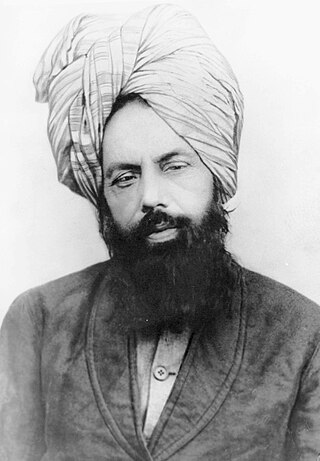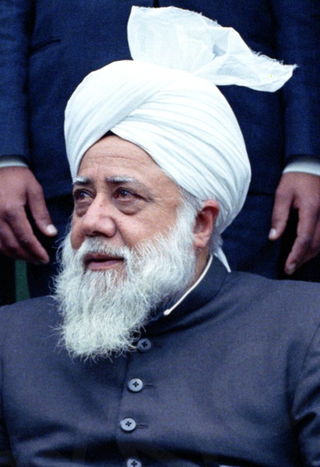
Mirza Ghulam Ahmad was an Indian religious leader and the founder of the Ahmadiyya movement in Islam. He claimed to have been divinely appointed as the promised Messiah and Mahdī—which is the metaphorical second-coming of Jesus (mathīl-iʿIsā), in fulfillment of the Islamic prophecies regarding the end times, as well as the Mujaddid of the 14th Islamic century.
Kausar Niazi, born as Muhammad Hayyat Khan and commonly known as MaulanaKausar Niazi, was a Pakistani politician and a religious leader in Zulfikar Ali Bhutto's Pakistan Peoples Party (PPP). Niazi, in Bhutto's premiership cabinet, was a most powerful federal minister in Pakistan during 1974 till 1977. Niazi was one of the close aids and trusted confidents of Bhutto who remained loyal to Bhutto until his death. He was born in Musakhel, Punjab, Pakistan. His father Fateh Khan Niazi Luqi-khel and uncle Muzaffar Khan Niazi Luqi-khel were among the leading persons of the area. He was a religious scholar and orator, who made a name for himself in politics, and was a member of Bhutto's Federal Cabinet. He served as a minister and assisted Bhutto for 6 years. He was also a member of the Pakistan Peoples Party.
Qadiyani Problem is a 1953 book written by Pakistani scholar Abul A'la Mawdudi. The term "Qadiyani" is a term which refers to members of the Ahmadiyya movement.

Syed Ata Ullah Shah Bukhari, was a Muslim Hanafi scholar, religious and political leader from the Indian subcontinent. He was one of the Majlis-e-Ahrar-e-Islam's founding members. His biographer, Agha Shorish Kashmiri, states that Bukhari's greatest contribution had been his germination of strong anti-British feelings among the Indian Muslims. He is one of the most notable leaders of the Ahrar movement which was associated with opposition to Muhammad Ali Jinnah and opposition to the establishment of an independent Pakistan, as well as opposition to the Ahmadiyya Movement. He is considered as a legendary rhetoric, which made him famous among the Muslims.
Events from the year 1953 in Pakistan.
On 19 June 1953 a Court of Inquiry was established to look into disturbances in the Punjab, Pakistan caused by agitation against the Ahmadiyya minority group. The disturbances prompted Martial law to be declared and dozens were killed by the military in the process of their quelling. The inquiry into the disturbances commenced on 1 July 1953. Evidence was concluded on 23 January 1954 and arguments on 28 February 1954. The report was issued 10 April 1954. The inquiry was headed by Chief Justice Muhammad Munir and its report is commonly referred to as the "Munir Report", or "Munir-Kiyani report".

Mirza Nasir Ahmad was the third Caliph of the Ahmadiyya Muslim Community. He was elected as the third successor of Mirza Ghulam Ahmad on 8 November 1965, the day after the death of his predecessor and father, Mirza Basheer-ud-Din Mahmood Ahmad.

Mirza Basheer-ud-Din Mahmood Ahmad was the second caliph, leader of the worldwide Ahmadiyya Muslim Community and the eldest son of Mirza Ghulam Ahmad from his second wife, Nusrat Jahan Begum. He was elected as the second successor of Mirza Ghulam Ahmad on 14 March 1914 at the age of 25, the day after the death of his predecessor Hakim Nur-ud-Din.

Mirza Masroor Ahmad is the current and fifth leader of the Ahmadiyya Muslim Community. His official title within the movement is Fifth Caliph of the Messiah. He was elected on 22 April 2003, three days after the death of his predecessor Mirza Tahir Ahmad.

The Ahmadiyya branch of Islam has been subjected to various forms of religious persecution and discrimination since the movement's inception in 1889. The Ahmadiyya Muslim movement emerged within the Sunni tradition of Islam and its adherents believe in all of the five pillars and all of the articles of faith required of Muslims. Ahmadis are considered non-Muslims by many mainstream Muslims since they consider Mirza Ghulam Ahmad, the founder of the movement, to be the promised Mahdi and Messiah awaited by the Muslims.
Mian Mumtaz Daulatana, was a Pakistani politician and a key supporter of Pakistan Movement in British India. After independence, he served as the second Chief Minister of West Punjab in Pakistan.

Ahmadiyya, officially the Ahmadiyya Muslim Jama'at (AMJ) is an Islamic messianic movement originating in British India in the late 19th century. It was founded by Mirza Ghulam Ahmad (1835–1908), who said he had been divinely appointed as both the Promised Mahdi and Messiah expected by Muslims to appear towards the end times and bring about, by peaceful means, the final triumph of Islam; as well as to embody, in this capacity, the expected eschatological figure of other major religious traditions. Adherents of the Ahmadiyya—a term adopted expressly in reference to Muhammad's alternative name Aḥmad—are known as Ahmadi Muslims or simply Ahmadis.

The May 2010 Lahore attacks, also referred to as the Lahore massacre, occurred on 28 May 2010, in Lahore, Punjab, Pakistan, during Friday prayers. 94 people were killed and more than 120 others were injured in nearly simultaneous attacks against two mosques of the minority Ahmadiyya muslim community. After the initial attack, a hostage situation lasted for hours. Tehrik-i-Taliban Pakistan, as well as their Punjab wing, claimed responsibility for the attacks and were also blamed by the Pakistani Police.

The Furqan Force or Furqan Battalion was a uniformed Battalion force of volunteers of the minority Ahmadiyya Muslim Community in the Dominion of Pakistan. Formed in June 1948 at the direction of Head of the Worldwide Ahmadiyya Muslim Community, Mirza Basheer-ud-Din Mahmood Ahmad, at the request of Pakistan government, the unit fought for Pakistan against India in the First Kashmir War. In addition to its troops being drawn from the Ahmadiyya population, the expenses of maintaining the unit were also paid by that community.

The 2005 Mong shooting was an Islamic Terrorist attack that occurred on 7 October 2005 in Mong in the Mandi Bahauddin District of Punjab, Pakistan. Eight members of the minority Ahmadiyya Muslim Community were killed inside a mosque as worshippers were performing Salat.

Majlis-e Ahrar-e Islam, also known in short as Ahrar, is a religious Muslim political party in the Indian subcontinent that was formed during the British Raj on 29 December 1929 at Lahore.
Mazhar Ali Azhar was a politician in British India and later Pakistan, and one of the founders of Majlis-e-Ahrar-ul-Islam. He was elected three times to the Punjab Assembly, took part in the Madhe Sahaba Agitation in Lucknow, and became a prominent opponent to the partition of India.
In the period spanning from late May to early September 1974, there were significant incidents involving the Ahmadi community in Pakistan. These incidents were marked by a series of events such as protests, violence, property damage, and governmental actions. The incidents occurred in various locations across Pakistan, including Islamabad, Peshawar, Hafizabad, Gujranwala, Lala Musa, Jhang, Wah Cantt, Burewala, and other localities. These events reportedly resulted in casualties among Ahmadi individuals and damage to Ahmadi mosques. Furthermore, in response to these events, the government took actions, including constitutional amendments, related to the status of Ahmadis.

Chaudhry Fateh Muhammad Sial (1887–1960) was a companion of Mirza Ghulam Ahmad and the first Ahmadi missionary sent from India, under the leadership of Hakeem Noor-ud-Din, the first Khalifa of the Ahmadiyya movement. In 1913, Mirza Basheer-ud-Din Mahmood Ahmad asked for volunteers to serve as Ahmadi missionaries in England. Sial volunteered and travelled to England on June 22, 1913 and arrived the following month. There he served twice as a missionary. He earned an MA in Arabic from the Aligarh Muslim University.
Majlis-e-Tahaffuz-e-Khatme Nabuwwat is the programmatic name of a Pakistani Barelvi organization and Islamic religious movement in Pakistan aiming to protect the belief in the finality of prophethood of Muhammad based on their concept of Khatam an-Nabiyyin. It was founded by Mohammad Abdul Ghafoor Hazarvi in 1950 with Zafar Ali Khan, Abdul Hamid Qadri Badayuni, Khwaja Qamar ul Din Sialvi, Syed Faiz-ul Hassan Shah, Ahmad Saeed Kazmi, Abdul Sattar Khan Niazi, Pir of Manki Sharif Amin ul-Hasanat, Muhammad Karam Shah al-Azhari, Sardar Ahmad Qadri and Muhammad Hussain Naeemi. Later on the prominent Barelvi leaders Shah Ahmad Noorani, Shaikh ul Quran Allama Ghulam Ali Okarvi, Pir Muhammad Alauddin Siddiqui, Muhammad Shafee Okarvi, Syed Shujaat Ali Qadri, Iftikharul Hasan Shah and Khalid Hasan Shah also joined them to oppose the Ahmadiyya Movement.










